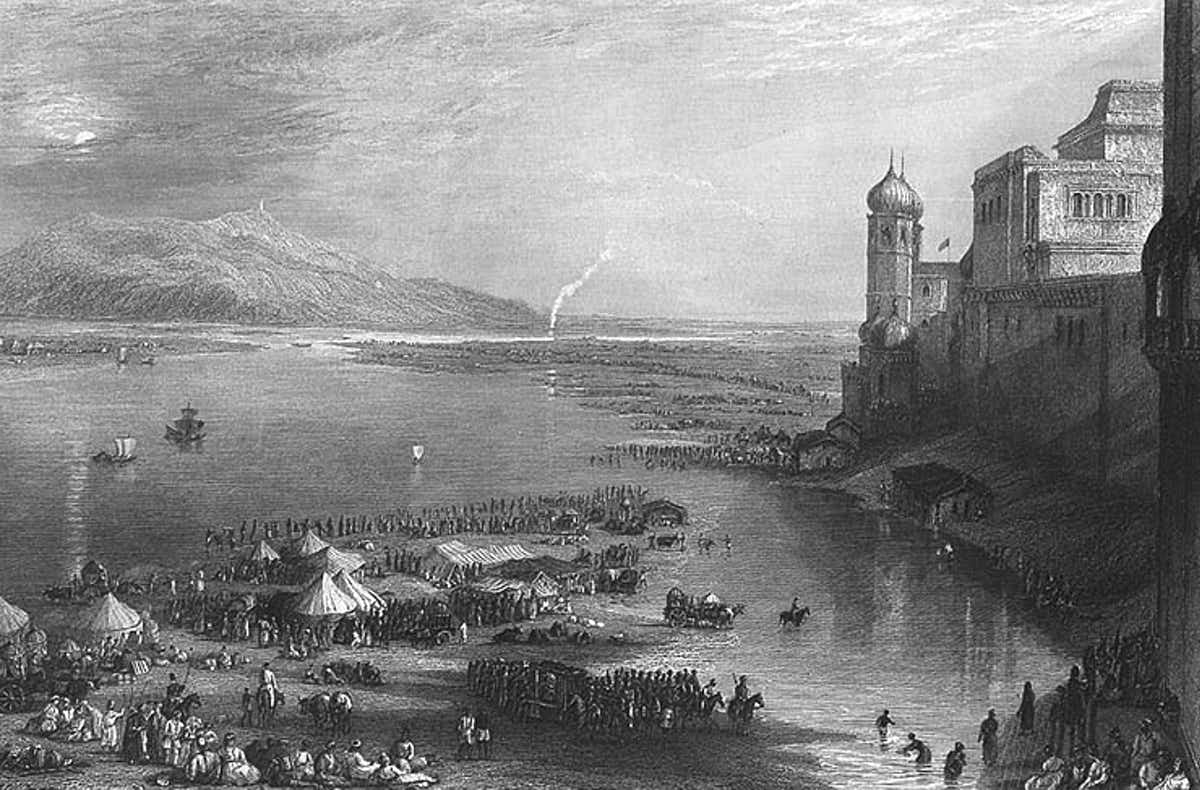
Kumbh Mela, also called Kumbha Mela, is a major pilgrimage and festival in Hinduism. Kumbha literally means "pot" in Sanskrit. In the context of Vedic texts, pot refers to water that symbolizes the nectar of immortality. The word Mela means "assembly" in Sanskrit, particularly in the context of fairs community celebrations. The Kumbh Mela thus implies an "assembly around water". Accordingly, it is celebrated at the four river-bank pilgrimage sites: Prayagraj (Ganges-Yamuna-Sarasvati rivers confluence), Haridwar (Ganges), Nashik (Godavari), and Ujjain (Shipra).
The festival is marked by a ritual of taking a dip in the waters as it is believed that bathing in these rivers is a means to atone for past mistakes and that it cleanses one of their bad karmas. Hindus also believe that bathing in the sacred Ganges on the auspicious days of the festival leads to moksha (salvation from the endless cycle of reincarnation). Another major attribute of the Kumbh Mela is the celebration of Hinduism what with numerous fairs, education, religious discourses by saints, mass feedings of monks, and entertainment spectacles spread across the entire duration.
Historical Origins
The tradition of Kumbh Mela was started by Adi Shankara, the 8th-century Hindu philosopher, who viewed a mass gathering of Hindus as an opportunity for philosophical discussions and debates on Hinduism across the Indian subcontinent. One can say that the objective has been met with a fair degree of success. In 1906, the Sanatan Dharm Sabha met at the Prayag Kumbh Mela and resolved to start the Banaras Hindu University under Madan Mohan Malaviya's leadership. Kumbh Melas have also been one of the hubs for the Hindutva movement and politics. In 1964, the Vishva Hindu Parishad was founded at the Haridwar Kumbh Mela.

While references to the Kumbha Mela per se are not found in the ancient texts, there are numerous chapters and verses in Rigveda Pariśiṣṭa (supplement to the Rigveda) that allude to a bathing festival, the sacred junction of rivers Ganga, Yamuna, and Saraswati at Prayag (Allahabad), and pilgrimage to Prayag. The Mahabharata mentions a bathing pilgrimage at Prayag as a means of prāyaścitta (atonement, penance) for past mistakes and guilt, but which must also be combined with values such as truth, charity, self-control, patience that one must live by. As per the Pali canons of Buddhism, Buddha believed that bathing in Prayag alone cannot wash away cruel and evil deeds, rather the virtuous one should be pure in heart and fair in action.
Types of Melas
The dates of the Kumbh Mela, which lasts between 1-3 months are based on the twelve-year cycle of planet Jupiter. The traditional start date of the Kumbh, Makara Sankranti (winter solstice) is in January. Until 2019, Kumbh Melas were held as per the following schedule:
- The Purna Kumbh Mela (full Kumbha) - every 12 years at a given site.
- The Ardh Kumbh Mela (half Kumbh) - every 6 years between the two Purna Kumbha Melas at Allahabad and Haridwar.
- The Maha Kumbh - every 144 years, after the completion of 12 Purna Kumbh Melas
However, during the 2019 Allahabad Kumbh Mela, the Uttar Pradesh chief minister Yogi Adityanath announced that the Ardh Kumbh Mela (organized every 6 years) will hereafter be known as "Kumbh Mela", and the Kumbh Mela (organized every 12 years) will be known as "Maha Kumbh Mela" (Great Kumbh Mela).
Rituals

People make the pilgrimage to the Kumbh Mela to observe and experience both the religious and secular aspects of the event. Most pilgrims stay for no more than a day or two, while some stay for the entire month of Magh. The two major groups that participate in the Kumbh Mela include the Sadhus and pilgrims. The Kumbh Mela is arranged in camps that give Hindu worshipers access to the Sadhus. Sadhus make themselves available to the Hindu pilgrims seeking instruction or advice in their spiritual lives.
Bathing, or taking a dip in the river waters is the central ritual of the Kumbh Melas. Amavasya is traditionally recognized as the most auspicious day for bathing. The thirteen sadhu akharas bathe first. This event, called shahi snan or raj yogi snan, is marked by a celebratory processional march, with banners, flags, elephants, horses, and musicians along with the naked or scantily clad monks. Once the monks have taken the dip, the festival day is opened for bathing by the pilgrims. The dramatic arrival of the akharas has become the signature visual of the Kumbh Mela. The most popular are the Nagas (who refrain from wearing any clothes), the Kalpwasis (who bathe thrice a day), and the Urdhawavahurs (who put their bodies through extreme austerities).
Many people come to the Kumbh Mela to honor one’s ancestors or dead parents and are aided by a priest who performs a yagna. The ceremony includes mundane (shaving off their hair), reciting hymns, and offering flowers. One of the other highlights of the event is the feasts where a vast number of people sit in rows and share a community meal – mahaprasada. The food, prepared by volunteers, is donated by individuals, and often sponsored by large companies as anna daan (food charity).
Size and scale
The festival which attracts millions of Hindus is regarded as one of the largest peaceful gatherings in the world and the "world's largest congregation of religious pilgrims". It has also been inscribed on the UNESCO's Representative List of Intangible Cultural Heritage of Humanity. As per the authorities, the largest single-day attendance at the Kumbh Mela was 30 million on 10 February 2013 and 50 million on 4 February 2019.
Expectedly, the logistics for an event of such scale are complex and entail significant expenditure. The expenditure for the 2019 Ardh Kumbh at Allahabad amounted to ₹44 billion or US$590 million for constructing a temporary city over 2,500 hectares with 122,000 temporary toilets and a range of accommodation from simple dormitory tents to 5-star tents, 800 special trains by the Indian Railways, AI-powered video surveillance and analytics by IBM, disease surveillance, river transport management by Inland Waterways Authority of India, and an app to help the visitors. The scale of the event demands a huge workforce. It is estimated that the mela creates between 6-7 lakh jobs.
TO READ THE FULL ARTICLE

Get full access to the exciting content on The Mirrority by logging in
Support independent journalism
Even the very best of media houses in our country today are yielding to the pressure of click-bait journalism in order to survive. More than ever before, our country needs journalism that is independent, fair and non-pliant to the bureaucracy. Such journalism needs the support of like-minded readers like you to help us survive editorially and financially.
Whether you live in India or India lives inside you, help us continue to produce quality journalism with your contribution.
CONTRIBUTE
